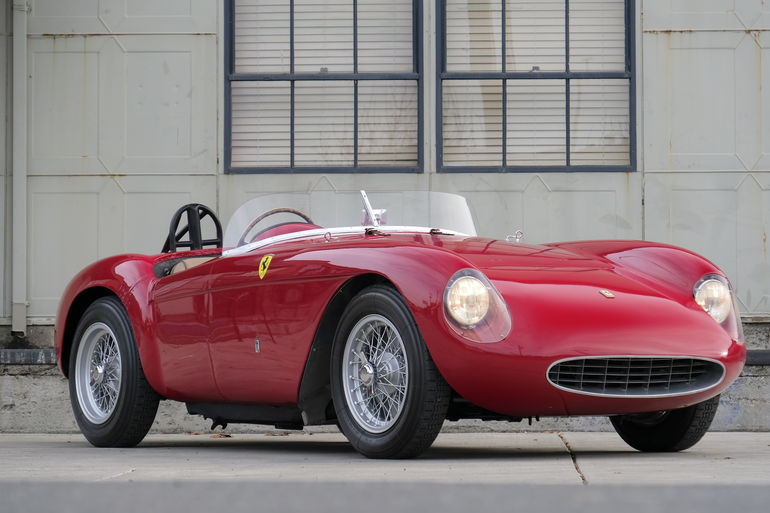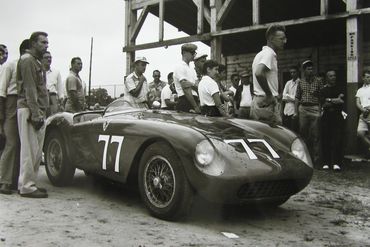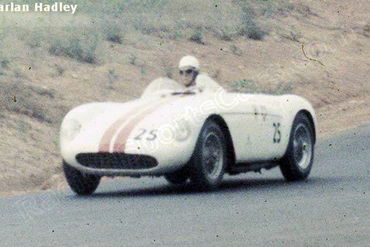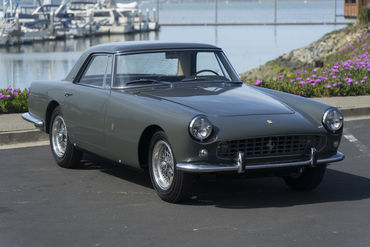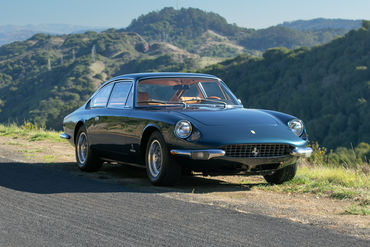Sold
SOLD 09/22
1954 Ferrari
500 Mondial by Pinin Farina
Privately Sequestered for Decades in Northern California, This 1954 Monza winner, US National Champion Mondial Embodies All the Glory of International Sports Car Racing. Eligible For Premier Worldwide Rally and Show Events. Without Question an Exceptionally Important Historic Competition Ferrari.
- VIN0430MD
- Exterior ColorRed
- Interior ColorTan
- MileageTMU
- Engine2.0L Inline DOHC 4-Cylinder
- Engine no.0464MD
- Transmission4-Speed Transaxle
- StatusSold
- StockFJ2452
Description
1954 Ferrari Mondial 500 by Pinin Farina
s/n 0430MD, Engine no. 0464MD
Red with Tan Interior
While most vintage Ferraris are well-known for their V12 engines, in the early 1950s Enzo Ferrari began taking notice of smaller profile cars using four-cylinder engines that made great power and delivered significant performance when installed in lighter weight cars. Particularly suited for racetracks with tight corners and limited straightaways, these cars were often highly competitive against larger, heavier big engine competition. Inspired by this, Enzo assigned engineer Aurelio Lampredi to immediately develop a robust and high revving engine. The end result would prove to be one of the most successful engine designs, delivering successes in race after race at the hands of some of the most capable drivers, including Alberto Ascari who proved the four-cylinder Ferrari was something to contend with, achieving consecutive championships in the four-cylinder F2 Monoposto, clinching the 1952 and 1953 titles.
The 1,984-cc dual overhead-camshaft Lampredi engine featured two Weber 40 DCOA/3 carburetors, four-speed manual transaxle, and offered a surprising 170hp. The power to weight ratio not only proved to be fantastic, in some cases, the performance could outdo the V12. Mounted into the tubular steel chassis, the independent front suspension with transverse leaf springs, de Dion rear axle with parallel trailing arms and semi-elliptic leaf springs, with four-wheel drum brakes, all contributed to making a very nimble race car with peak torque at lower rpms. The combined package was not only nimble, but the engine also delivered great acceleration especially on tight racecourses and hill climbs.
By 1954, Ferrari offered the four-cylinder sports/racer to customers as a two-liter model, with each cylinder displacing almost 500 cubic centimeters. The car was dubbed the 500 Mondial, in recognition of Ascari’s back-to-back World Championships. Beginning with chassis 0404MD, 18 spiders and two berlinettas were built comprising the first series, all of which were bodied by Pinin Farina. A second series of 10 Scaglietti-bodied cars followed, resulting in the construction of just 30 500 Mondials before yielding to the three-liter 750 Monza. And, while any Mondial is surely a rare and desirable Ferrari, chassis #0430 stands today as a singularly remarkable example with highly desirable “low grille” covered headlight alloy coachwork, featuring period racing history and long-term ownership. Sequestered for decades from exposure or exhibits at major events, this beautiful Mondial reflects not only the stunning craftsmanship and mechanical excellence of the era, it remains true to the original intent of this series, preserving the authentic debut racing achievement garnered in Italy and multiple period North American racing wins throughout the 1950s.
According to the Marcel Massini report and other supporting documents authenticating this car, on May 18, 1954, chassis 0430 (tipo 504) entered the Pinin Farina facility for alloy body construction. Designed and constructed at the factory with the desirable “covered-headlight”-style bodywork, the car is believed to be the 10th 500 Mondial built, transitioning from the earlier designs into the more refined and smoothly contoured low grille profile.
On June 27, 1954 #0430, nearly completed, was pulled from the production line and called into racing duty. The 2.9L 735 engine, #0428MD, was installed in time to compete at the 2nd Grand Premio Supercortamaggiore in Monza, driven by legendary race car driver Mike Hawthorn and co-driver Umberto Maglioli. Hawthorn, an accomplished Scuderia Ferrari driver would go on to achieve the 1958 FIA Formula One World Championship for Ferrari as well as numerous other victories in a wide range of Ferraris. The intrepid team performed flawlessly, delivering a 1st overall in race #14 at Monza, which ultimately would lead to this series of cars becoming known as the “Ferrari Monza”. This first-place finish has been well documented by Motor Sport magazine in an article about the race published in 1954 (see accompanying article).
As was common for that period, this Monza winning car, having achieved victory, was returned to the factory to be outfitted with engine #0430 and sold as a brand-new car. An order was processed for Bill Frick Motors, USA for customer William Carpenter. The car was painted blue with a central white stripe, and delivered to the first owner, Mr. William K. Carpenter, Montchanin, Delaware in October 1954. Later that year, Carpenter sold the car back to Bill Frick, West Palm Beach, Florida, who then offered the car for sale in the January 1955 issue of Road & Track magazine, page two. In that advertisement, the car is described as “brand new, never raced, painted dark blue with a wide white stripe, asking price $11,000.00”. In November 1955, the car was sold to Paul Norair, Washington, DC.
After Norair purchased the car, he entered it in its first North American race, the 2nd Annual Nassau Speed Week, Bahamas on December 9th, 1955, race #92, placing 29th overall in the Governor’s Trophy, and 2nd in class E. The next day, on the 10th of December 1955, the car competed in the Alberto Ascari Memorial Trophy (Ferrari Class Race 6), driven by Norair also #92, and again on 11th of December 1955, it further competed in the Nassau Trophy with co-drivers Carl Smidt and Campbell sharing driving duties placing 23rd overall and 3rd in the EM class. In the spring of 1956, the car was repainted to red and went on to participate in numerous documented races, completing two additional years of competition at some of the most important North American race venues. Over 30 entries including races at Watkins Glen, Lime Rock, Nassau Bahamas, Marlboro, Bridgehampton, and Cumberland are documented in the Massini report and further supported in entries noted on Ferrari car database barchetta.cc.
On February 1, 1957 the car was advertised for sale in Sports Car Magazine with the advertisement noting “7 races, 6 trophies, excellent, retiring, $4,950.” In May 1957 the car was sold to Mike Gerber, Framingham, MA and extensively raced by Gaston (Gus) Andrey while under Gerber’s ownership. During this period, Andrey raced the car in white livery with twin red stripes and Swiss flags proudly flanking its sides, achieving 1st place in the 1957 E modified class, with Andrey also winning the 1957 SCCA E Modified National Championship. Further racing distinctions with Andrey at the wheel included victories at Watkins Glen GP (1st EM, 11th OA), Bridgehampton, and numerous SCCA Regional races at Limerock.
The next known owner, Charlie Kolb competed with the car throughout 1958 at Vineland, Cumberland, VIR, Marlboro, and Berwick. In the 1960s the car was sold to H. Anderson, a resident of Atlanta, Georgia who sold the car to Robert Norwood, Denton, Texas, around the mid 1970s. At the time of his purchase, the car is believed to have been sold without the engine. By the mid 1970s Norwood arranged for the purchase of a Ferrari engine from Robert Lloyd in Texas. In 1976, the car was then offered for sale by the broker Katherine McClure, Manchaca, TX.
At this time, the car is known to have been fitted with engine #0464, itself a critical part of Ferrari racing history, having powered a Mondial Spyder Scaglietti which debuted at the Carrera Panamericana driven by Porfino Rubirossa and Ernie McAfee, ironically with DNQ for “exceeding the time limit”, and later logging a DNF at the 12 hours of Sebring due to an accident. After the accident, Engine #0464 was removed from the car and subsequently installed in chassis #0430.
In 1979 Bob Taylor, Burlingame, CA acquired the car, advertising it for sale, paired with engine #0464MD. Taylor, a well-known Bay Area proprietor of racing Ferraris, had supplied numerous cars to a wide range of West Coast buyers and privateers. In 1980, the Mondial was sold to the most recent Northern California owner, who retained the car until his passing.
The recently departed private owner, a well-respected Northern California afficionado and sports car enthusiast was an exceptional caretaker of this historic and important Ferrari. During his ownership, he worked methodically restoring the car, employing a range of Bay Area experts on specialized tasks. In 1995, the original engine #0430MD, was offered for sale by Corrado Cupellini, Bergamo, Italy, and subsequently sold to a buyer in France. Being quite familiar with Ferraris and having access to some of the finest Ferrari mechanics in California and other experts worldwide, the owner restored the car to a high standard with the former Sebring 0464MD motor which has been a proud part of this car for more than 40 years.
During the restoration, Doug Peterson of Comptech was enlisted to perform careful mechanical work on the lower end of the motor including the installation of a new Moldex crank, robust stock rods, and new pistons. The car was then dispatched to Phil Reilley for further engine work. During this time, Ferrari engine expert Jere Brown of Mouse Engineering worked on the head and barrel to correct a previous leak. Brown, having performed work on several mechanical aspects of this car, was careful to maintain as many of the original parts and components as possible. Detailed accounts of all mechanical work were retained with the records for the services. While the engine was being serviced, the clutch was replaced, and the gearbox inspected and then reinstalled in the car. Bay Area painter Rob Etcheverry, known for his expert workmanship on Ferraris, painted the car in rosso corsa.
Over the past 40 years, the car has remained largely out of sight, safely stored in Northern California, the subject of a private collector’s passion, now transferred to his dedicated family estate with the desire to extend the preservation of one of the finest examples of 1950s Ferrari motorsports to a new patron. In addition to the records supporting the mechanical work performed on the car, there are numerous copies of original documentation supporting the history of the car including copies of the original Ferrari certificate of origin and a January 2021 Marcel Massini report.
Today this Mondial 500 presents in excellent condition with beautiful paint and overall cosmetics that are proudly representative of the older but refined restoration. A tribute to the fine workmanship of Etcheverry, the paint is glossy and very well-preserved, in part due to the care and minimal exposure the car has seen while under the same ownership for the past 40 years. The quality of the car is very satisfying overall from the correct instrumentation, removable head fairing, passenger compartment alloy tonneau, and the properly prepared twin cam engine with original Weber carburetors. The engine, once featuring dual magnetos, has been converted to twin distributors and has recently benefited from mechanical inspection by expert Patrick Ottis who worked on the brakes and fuel system in preparation for consignment.
Given the years of racing, the condition of the car remains a testimonial of the remarkable historic stewardship, validating the skilled artisans and engineers that have lovingly preserved this unique Ferrari. In addition to the beauty of the Pinin Farina bodywork, the car displays all the hallmarks of the original Gilco constructed frame 63218 E4 supplied for Ferrari. The original Ferrari chassis plate is also in place, properly affixed to the cowl. Cosmetically, the paint has settled over time, displaying an overall look and feel of the exterior that is cohesive and harmonious.
The low grille, placed below the steeply dropped front panel, is unique to this sequence of Mondials. Although the front of the car has been blended over the original construction rivets and the grille perimeter slightly altered during the restoration, the final result is an authentic result in keeping with the character of the original. The distinctive body side contours, gently undulating rear deck, and inner flanged edges also retain the unique construction rivets. The desirable covered headlights, inset aluminum grille, low profile windscreen, and hood straps add finishing racing touches to the look of the car. Further competition touches include the aluminum outside filler cap, distinctive three-louvered hood and tonneau, and wood-rimmed steering wheel peeking out from the cockpit.
The panel fit is excellent for all openings with smooth perimeter edges along the alloy folds and correct finishes along the inside panel areas. The body lines are dramatic and beautifully executed with excellent reflection lines, showing exposed rivet joints at aft body sections for the doors and rear fender sections and surrounding the inner folded flange of the cockpit. Borrani wire wheels are correctly finished in satin silver paint, with chrome plated dual ear knockoffs, mounted with Michelin tires.
The interior is finished with satin black over the metal and aluminum inner structure. Very much a race car in overall fit and finish, the driver’s seat is covered with durable tan material, contoured for competition driving. The instruments are beautifully finished with excellent color, clarity, and details. Only the fuel gauge shows signs of age, with slightly yellowed lettering, reflecting its originality.
The hinged trunk reveals a Borrani spare wheel held in place with leather straps, rear filling fuel tank, and, once again, original trunkline construction rivets for the body panels and fuel tank. Throughout the interior there is a wonderful combination of vintage integrity, original construction, and genuine preservation for this piece of history – a unique blend of care and harmony heralded by its original racing purpose and preserved by a lineage of admiring enthusiasts.
Unlatching the leather hood straps, the alloy hood easily lifts off revealing the beautiful Mondial engine in all its artistic and mechanical glory. As evidenced in the trunk the perimeter of the folded aluminum engine compartment flange shows the rivet construction typical of original body work from this era. With no cumbersome or heavy air cleaner, the side draft dual-throat Weber carburetors trumpet proudly, flanking the twin overhead cam engine, through their polished air horns. The engine castings, hardware, fittings, and iconic finishes present honestly and correctly as a proper Ferrari should. With only the modest passing of time having treated some of the finishes to warm coloration and fuel-toning to various metal parts.
Upon consignment, the car was carefully brought out of storage by Ferrari expert Patrick Ottis who, having been previously familiar with the car from mechanical services performed in the 1980s, inspected the car ensuring proper operation of the brakes, including installing all eight new wheel cylinders, a re-sleeved master cylinder, and work on the fuel system.
The engine compartment is a highlight of technical sophistication and engineering artistry, further boasting the history of racing at Sebring. The underside of the car has been properly cared for consistent with the restoration and general care.
Opening the lightweight alloy driver’s door, the interior is all business, inviting you into a literal time machine of racing past. Slipping into the driver’s seat, one is immediately reminded of the debut race in this car when racing legend Mike Hawthorn sat in this very same place finishing first overall at the 1954 Grand Premio Supercorte Maggiore in Monza. With a joyful spark and instant ignition, the twin-cam engine erupts into a snappy roar, capturing the spirit and vitality of these lightweight agile race cars. Throttle response is sharp, and the side exit exhausts a raucous reminder of the many races this car has completed in its racing career.
Rare by any measure, documented and validated by numerous Ferrari authorities, and capable of participating in every possible historic motorsport event or concours, this Mondial 500 has remained hidden for decades, quietly pleasing its long-term owner, preserved and protected for the next enthusiast to enjoy. Originally driven by Mike Hawthorn, raced in North America throughout the 1950s, and treasured under 40 years of current, now estate ownership, this remarkable Ferrari Mondial is a true tribute to the icons of 1950s racing. With its stunning Pinin Farina body design, low grille, covered headlight configuration, and reputable documentation, this Ferrari is truly an unrepeatable example of one of the finest competition cars built during the height of racing excellence and the rise of Ferrari as a dominant motorsports company.
Please note:
Some historical information courtesy of Tazio Ottis.
This Ferrari 500 Mondial is titled in California as a 1953 year model.
The above vehicle information is complete and accurate to the best of our knowledge at the time it is posted to this website. Corrections or additional information is always appreciated. All advertised prices exclude government fees and taxes, any finance charges, any dealer document preparation charge, and any emission testing charge. Vehicles are subject to prior sale. All advertised to be true but not guaranteed. We assume no liability for errors or omissions.
Inquire About This Car
Fantasy Junction • 510-653-7555 • 1145 Park Ave, Emeryville, CA 94608
